In nature, there are two types of life strategies: r-selected and k-selected.
R-selected
 |
| Ants are found in millions in the environment. They are characterized as r-selected organism, specially, due to their number of offspring and the lack of parental carrying. |
This species reproduce as close as the their biotic potential as they can get, representing the extreme size along a continuum.
K-selected
Organism organism are usually found in stable and predicted environment. They produce number of offspring that is close to their carrying capacity, since they
have to deal with several factors, for example competition for limited resources like food. This organism are usually big sized and have a long life spam.
 |
| Whale are known to nurse their offspring for several years. |
It is very important to remember that the use of k-selected and r-selected descriptions for an organism will depend on who are they be compared to. Rats are usually say to k-selected organisms, however, they r-selected when compared to human beings.
Nenhum comentário:
Postar um comentário